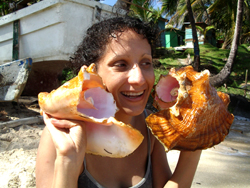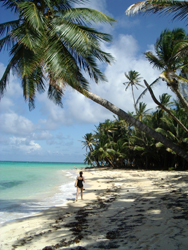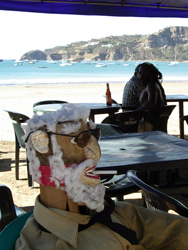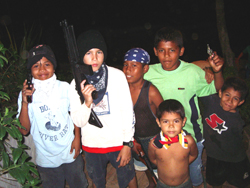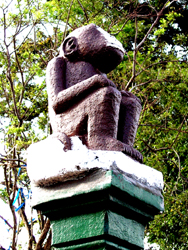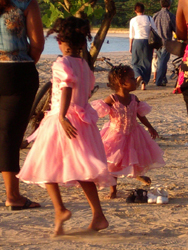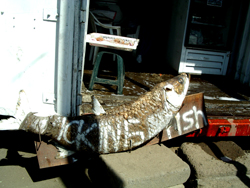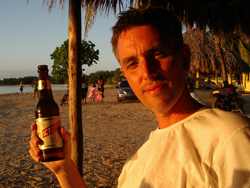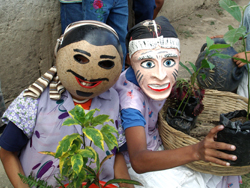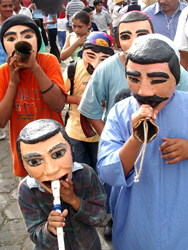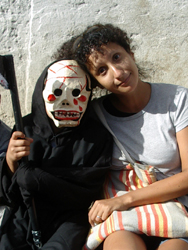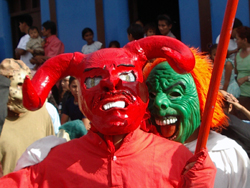Escapades on the Escondido
Dispatch from Corn Island, Nicaragua - January 2005
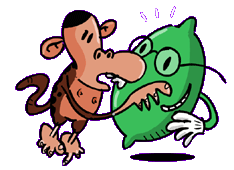
| V. Poor Prose Managua,
Nicaragua what a wonderful spot! — Albert Gamse Yes, Nicaragua
is still a wonderful country full of wonderful people, oodles of history
and fabulous sounding places (Tipitapa, Momotombo, Sally Peachy, Rio
Wanke, etc.). Hard to believe in so many ways that it’s still
only a few hours by bus from Honduras. |
|
|
|
You say Miskito, I say Mosquito Corn Islands, a pair of tertiary period volcanic basalt land masses in the rainbow blue Caribbean. A slice of paradise as yet undiscovered by the masses with forested hills, mangrove swamps and long litter free stretches of coral white sands and turtles, sharks, the lot! Bizarrely Little Corn—a hair-raising 30 minute speedboat ride across the waves away— is more developed with an actual hotel although no cars. They do sell the best coconut bread in the world. Here we spent an idle week in our own little paradise, jumping in the ocean blue and treking through the lush vegetation.
|
| The Corn Islands were flattened
by hurricane Joan in 1988 destroying the coconut industry and now they
are looking to replace the empty coffers with tourism dollars. They
have a remarkable history as well. It was the resting place of pirates
on their way too and from raids to the mainland. In fact many of the
current inhabitants are direct descendants s from Pirates and English
royalty and plantation owners. The native Kukra Indians had a habit
for eating human flesh which did not bode well for vegetarian food potential.
The first English visitors called them the Skeleton Islands. Tourists
love that stuff. I know I do. |
|
|
But
even a Caribbean Island paradise has a dark side. We should have seen
it coming. Rather than the folksy sounding places like Sally Peachy
and Picnic Cove our hotel was located on “Sand Flea Point”.
At one point I counted over fifty bites on my body. Animals had it in
for me this trip. A few days later there I was soaking myself in a nice
sandy shallow lagoon on Christmas Day, quietly minding my own business
and generally being respectful when a crab nipped me in the fetlocks.
I yelped and flung my leg up with the crab still attached (I’m
a cartoonist, what do you expect). It made quite an incision and the
blood would have been enough to attract sharks I suspect. |
We amused
ourselves walking around the entire Island. In the darkest recesses
of Corn Island we encountered a friendly local called Ira who had a
dog with no ears. We asked why the dog had no ears (no this is not a
bad joke) and he said when it was a puppy he thought it was a Doberman
Pinscher and had clipped the ears with a machete (blindfold it seemed)
but it turned out to be a dog that was very unlike a Doberman Pinscher
and looked even sillier with no ears. |
|
|
The Agua in Managua All journeys in Nicaragua eventually take you through Managua where we saw perhaps the saddest site of all. A group of street urchins running behind a trash truck begging for items to be thrown back. It doesn’t take a roving eye for trouble to see this sort of thing all over Nicaragua where trash is at least dumped into one area which is then combed through many times by the desperate the destitute. There is a lack of this in Honduras, one thinks because of the death squads during the 80s who were known to make people disappear. In a pet shop I spotted one-eared hamsters. There was a little scab where the other ear should have been. I wondered if perhaps someone had mistaken them for Doberman Pinschers but when I went back after Christmas to photograph them and they had all been sold or euthanized. |
| A monkey escaped at a hotel where we were staying in Managua. In a (thankfully) largish cage next to the swimming pool there is a family of three chattering white-faced monkeys at the Hotel Los Felipe one of which (Chemo) starts masturbating as soon as you approach the cage. Now there’s a saying “more fun than a barrel of monkeys” and although there was no barrel in sight and just the one primate (albeit liberated) there were laughs-a- plenty. If you lock up a monkey you deserve the face the consequences when they get out and it got up to all sorts of mirthful antics that left us. No one could catch the monkey. It was far too clever until it had its trust betrayed by me, the anthropoid Judas. I felt bad after but the gleeful staff did promise that they would let them out again on “Thursdays” for exercise. |
|
|
|
Surfing Tsunamis We walked to Carolina
which sits on the lip of the crater. December 31st marks the festival
of “Torro y Venado”. Everyone loves a procession. In Latin
America they do processions especially well. San Silvestre was being
celebrated on this particular day. Everyone was dressed like Day of
the Dead or Halloween. Small children were waving chickens. People were
grinding corn and selling shrubs and generally going ape. |
|
Escapades on the Escondido Julia’s mother had grown up along the Rio Escondido. Her grandmother had been a cook on a Scottish logging boat. We thought it would be a swell idea to reenact those bygone sepia days. The Bluefields Express is one of only
two ways to travel the vast geographical divide between the two Nicaraguan
coasts. The land/river route connects the Spanish-speaking Pacific side
with its smoking volcanoes and revolutionary past to the lush jungle
Caribbean side of coconut palms and crocodile swamps. The Miskito Coast
was discovered by the Spanish, used as a hideout by pirates, claimed
by the British, colonized by shipwrecked slaves and developed by US
lumber and banana industries and has resulted in a fascinating conglomeration
of history. |
|
|
|
The daily carnival of noise and color erupts every evening in a market on the outskirts of Managua as travelers arrive for the overnight journey. It would be hard to find a more glaring contrast to illustrate the cultural gap between the “two Nicaraguas” as the drab slum rustling with children digging through piles of trash is momentarily filled with Caribbean colors, Creole dialects and “puntero” music blaring from radios. We purchased our
tickets and squeezed into our seats. The decrepit buses were thick with
the odors of overheated bodies, ripe bananas and mildew. Before we set
off a bus inspector video-taped everyone “for security”
we were told. The busses travel in a convoy, the isolated route a haven
for drug trafficking and bandits. |
The road was muddy and in poor condition even by Nicaraguan standards. It had been a strategic battleground during the revolution as it was the only connection between Managua and the port at El Rama. Seemingly in a constant state of repair, the combination of war, old age and neglect have left it with axel-braking craters along its entire length. Painted rocks were often all that marked the edges of the road. In the dim light through the dirt-caked windows I could make out small settlements and dilapidated gas stations. We rattled across the rugged terrain, our spinal columns jarring on every pothole. |
|
|
|
Sometime after midnight I awoke from slumber with the immediate thought that something was about to happen. We were in fact out of control. The driver had dozed at the wheel, woke up in time to jerk the bus violently only to send us sliding in the soft mud and careening into an embankment. The impact was
with enough force to bring all the seats back to the upright position
with a snap. The windscreen cracked into ripples. Dazed and confused
we stumbled off the bus to stare at the damage. The driver stood around
smoking and inspecting the puddle of gasoline that was seeping from
the underside of the bus. Finally, with few other options, he started
the engine and incredibly, at the third attempt it rumbled into life,
we backed up and continued onwards. I was too tired to succumb to panic
and nausea. |
We were the last bus to arrive at El Rama where we transferred to water taxis or “pangas” to snake up the twisting labyrinthine of swamps, channels and jungle river that comprise the Rio Escondido (the hidden river). At the dock was a bemused mass of people, half-asleep and wobbling in the darkness down a plank and onto the simple single-engine boats that congealed around the dock. A clipboard was passed around. Everyone had to write down their name, age and sex “in case of accidents”. The “pangas”
were stuffed with 12 to 15 people each depending on the quantity of
luggage being carried. The boats half sunk until you could no longer
read the names on the side and it seemed the slightest tip would capsize.
All around was silence but for the rhythmic repetitive yelling of the
vendors “La quajada, la crema, café caliente” (cheese,
milk, hot coffee). |
|
|
In our panga a one-hundred year old blind Miskita woman was lowered on board. She was traveling upriver for medical care. She sat loudly hacking sputum into the darkness. I sat next to a chain-smoking man with one white hair for an eyebrow. We sat for two hours waiting for the first light. The mist that enveloped us concealed a silent black millpond-still soup. As the sky began to lighten the inky black river turned gray. The mist burned off and was replaced by the smoke of diesel engines as we shuddered away. The river was so wide that
we were never troubled by the wake of passing boats. Palm trees leaned
out as if frozen in an attempt to drive from the bank. Much of the sadly
deforested embankment revealed isolated communities living in stick
huts on stilts with thatched roves of palm fronds. |
Then the rain started. With no cover the driver passed out a huge plastic tarp that we were told to hold it down. Flapping wildly in the wind it did little to keep us dry and we could feel the torrent pelting our heads with the vehemence of machine gun fire. Ninety minutes later we arrived soaked and numb at the bustling port at Bluefields. There is thankfully one other way to travel between Managua and the Atlantic coast and for the return journey, perhaps a little wiser for the experience, we chose to fly. Until next time... |
|
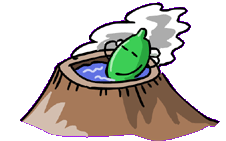
Previous dispatch | Next dispatch
©
J. Lemon / Lemonworld 2005. All rights reserved. This
web site is not an official publication of the Peace Corps or the U.S.
Government. The contents of this Web site reflect the personal opinions
and observations of the individual(s) contributor(s) and do not reflect
any position of the U.S. Government or the Peace Corps. |
